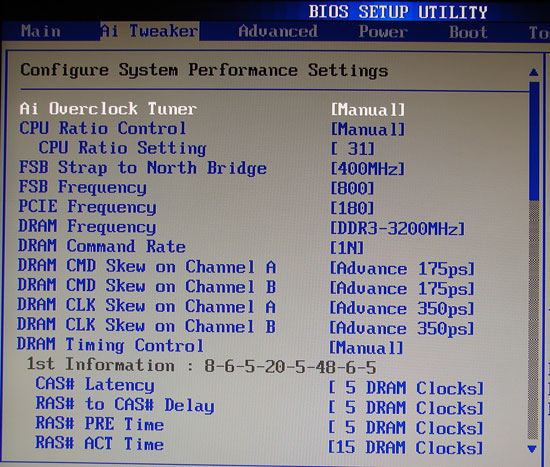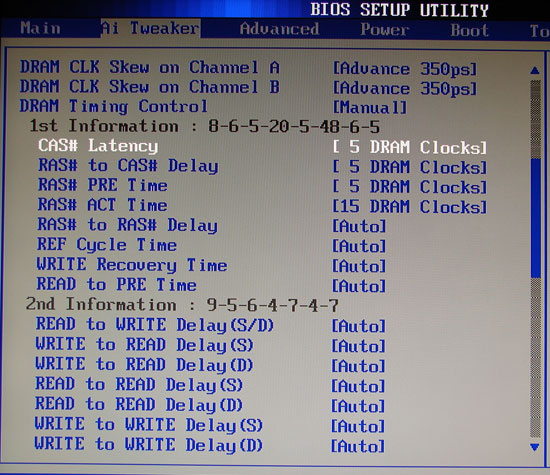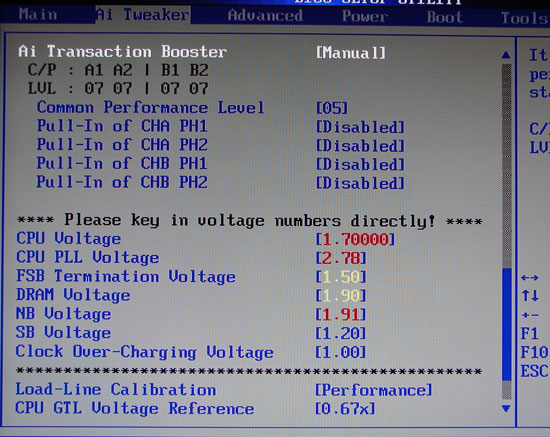ASUS P5E3 Premium: Features and BIOS Changes
The P5E3 Premium board is designed for the general enthusiast with an emphasis on features designed for the home user, whether it is for gaming or home theater usage. ASUS provides two eSATA ports via the JMicron JMB363 chipset, IEEE 1394 support from Agere, excellent on-board audio support from the ADI 1988B, an 802.11n Wireless port, and dual Gigabit LAN capability.
The board offers a very good mix of expansion slots although utilizing a CrossFire setup will create the physical loss of a PCI Express x1 and PCI slot. The third PCI Express x16 slot operates at x4 electrically and can be utilized for various PCI Express cards including AGEIA PhysX, RAID controllers, or a third video card at this time.
We will go into the BIOS settings in additional detail once we receive the retail kit and official launch BIOS. However, the following screenshots represent features that we know will be in the retail BIOS.




The P5E3 Premium BIOS has undergone a makeover of sorts. The AI Tweaker section is still in place with a wide variety of options for tuning the board. Although not as extensive as the latest DFI enthusiast boards, the options available have been expanded. The notable addition being the revamped the Transaction Booster setting. The Transaction Booster option is actually another name for tRD (Performance Level) and can be adjusted from 31 down to 1. ASUS joins DFI now in offering this setting that greatly affects latencies and overall system performance. The DRAM timing control sections now offers 23 different memory settings.
Our screenshots show the maximum value for each option. ASUS has listened to the power users and now offers CPU voltages to 2.10V and MCH voltages to 2.21V provided the OC jumper on the motherboard is enabled. ASUS has also included the ability to save BIOS profiles, although it is currently limited to two profiles.
| ASUS P5E3 Premium | |
| Market Segment | High Performance Enthusiast - $299.99 (estimated) |
| CPU Interface | Socket T (Socket 775) |
| CPU Support | LGA775-based Core 2 Duo, Core 2 Extreme, or Core 2 Quad Recommended |
| Chipset | Intel X48 (MCH) Northbridge and ICH9R Southbridge |
| FSB Speeds | Auto, 200 ~ 800 in 1MHz increments |
| Memory Speed (DDR3) | Auto, Eight Ratios dependent upon Strap Setting |
| FSB Strap | Auto, 200, 266, 333, 400 |
| PCIe Speeds | Auto, 100MHz - 180MHz |
| PCI Speeds | Locked at 33.33MHz |
| Core Voltage | Auto, 1.10000 to 1.70000 in .00625 increments, plus settings to 2.10V with OC jumper enabled. |
| CPU Clock Multiplier | 6x ~ 12x, downward adjustable for Core 2, upward to 31 for Extreme |
| DRAM Voltage (DDR3) | Auto, 1.50V ~ 2.78V in .02V increments, 1.50V standard |
| DRAM Timing Control | Auto, Manual - 23 DRAM Timing Options (tCL, tRCD, tRP, tRAS, tRFC + 18 sub-timings) |
| DRAM Command Rate | Auto, 1N, 2N |
| NB Voltage | Auto, 1.25V ~ 1.91V in .02V increments, plus settings to 2.21V with OC jumper enabled. |
| SB Voltage | Auto, 1.05V, 1.20V, 1.05V standard |
| FSB Termination Voltage | Auto, 1.20V to 1.50V in .02V increments, 1.20V standard |
| Clock Over Charging | Auto, .70V to 1.00V in .10V increments, .80V standard |
| CPU Voltage Damper | Auto, Enabled, Disabled |
| CPU Voltage Reference | Auto, .67, .65, .63, .62 |
| NB Voltage Reference | Auto, .67, .61 |
| AI Clock Twister | Auto, Light, Medium, Strong |
| DRAM CLK Skew CA/CB | Auto, Normal, 50ps to 350ps either advance or decrease |
| DRAM CMD Skew CA/CB | Auto, Normal, 25ps to 175ps either advance or decrease |
| AI Transaction Booster (tRD) | Auto, Manual, settings from 31 to 1 |
| Memory Slots | Four 240-pin DDR3 DIMM Slots Dual-Channel Configuration Regular Unbuffered DDR3 Memory to 8GB Total |
| Expansion Slots | 3 - PCIe x16 (2 - x16, 1 - x4 electrical) 2 - PCIe x1 2 - PCI Slot 2.2 |
| Onboard SATA/RAID | 6 SATA 3Gbps Ports - ICH9R (RAID 0,1, 10, 5) 2 eSATA 3Gbps Port - JMicron JMB363 |
| Onboard IDE | 1 ATA133/100/66 Port (2 drives) - JMicron JMB363 |
| Onboard USB 2.0/IEEE-1394 | 10 USB 2.0 Ports - 6 I/O Panel - 4 via Headers 2 FireWire 400 Ports by Agere FW3227 - 1 I/O Panel, 1 via Header |
| Onboard LAN | Realtek RTL8110SC - PCI Gigabit Ethernet controller Marvell 88E8056 PCI Express Gigabit Ethernet controller ASUS 802.11n Wireless Port |
| Onboard Audio | ADI 1988B - 8-channel HD audio codec |
| Power Connectors | ATX 24-pin, 8-pin ATX 12V |
| I/O Panel | 1 x PS/2 Keyboard 2 x eSATA 2 x SPDIF - Optical Out, Coaxial Out 1 x IEEE 1394 1 x Audio Panel 2 x RJ45 6 x USB 2.0/1.1 |
| Fan Headers | 6 - CPU, (5) Chassis |
| Fan Control | CPU and Chassis Fan Control via BIOS/AI Suite, PC Probe II monitoring |
| BIOS Revision | v110 |
| Board Revision | v1.00 |
The P5E3 Premium board is designed for the general enthusiast with an emphasis on features designed for the home user, whether it is for gaming or home theater usage. ASUS provides two eSATA ports via the JMicron JMB363 chipset, IEEE 1394 support from Agere, excellent on-board audio support from the ADI 1988B, an 802.11n Wireless port, and dual Gigabit LAN capability.
The board offers a very good mix of expansion slots although utilizing a CrossFire setup will create the physical loss of a PCI Express x1 and PCI slot. The third PCI Express x16 slot operates at x4 electrically and can be utilized for various PCI Express cards including AGEIA PhysX, RAID controllers, or a third video card at this time.
We will go into the BIOS settings in additional detail once we receive the retail kit and official launch BIOS. However, the following screenshots represent features that we know will be in the retail BIOS.




The P5E3 Premium BIOS has undergone a makeover of sorts. The AI Tweaker section is still in place with a wide variety of options for tuning the board. Although not as extensive as the latest DFI enthusiast boards, the options available have been expanded. The notable addition being the revamped the Transaction Booster setting. The Transaction Booster option is actually another name for tRD (Performance Level) and can be adjusted from 31 down to 1. ASUS joins DFI now in offering this setting that greatly affects latencies and overall system performance. The DRAM timing control sections now offers 23 different memory settings.
Our screenshots show the maximum value for each option. ASUS has listened to the power users and now offers CPU voltages to 2.10V and MCH voltages to 2.21V provided the OC jumper on the motherboard is enabled. ASUS has also included the ability to save BIOS profiles, although it is currently limited to two profiles.










19 Comments
View All Comments
Kougar - Saturday, November 17, 2007 - link
Ah, you are correct. G45 will be the GMA X4500 with DX10 and HD playblack offloading support, if the wiki is anything to go by. At least they seem to understand Intel's nomenclature! But that makes two of the three G31, G33, and G35 pretty superfluous, since they supposedly use mostly similar or different variations of the same G965 design that G45 will then supersede? I had thought G35 was released, but you are also correct it has not. G45 is due at the same time as the rest of the 45 chipset launches in 2Q'08, so what is the point of launching G35 just for one quarter except to help push more parts?Sadly this does not explain P45 or X48... both of which only offer a higher official FSB rating. Suffice to say if X48 doesn't offer any improvement over X38, then why would P45 offer the same over P35. X38 is nothing more than a P35 with extra PCIe lanes, which is fine, but it makes P45 and X48 rather moot points. The goal of a business is to turn a profit, but forcing a steady stream of superfluous rebadged "new" hardware down the industry's throat is not a good thing.
ninjit - Wednesday, November 14, 2007 - link
Personally I really wish they dropped PS/2 altogether from new motherboards, but I find it a little odd that they included a PS/2 Keyboard port, but no mouse one.
I thought it might be a typo, but the board picture only seems to show the purple keyboard ps/2 port as well.
Gholam - Sunday, November 18, 2007 - link
Intel DP35DP has a nice little bug where you get locked out of the system after doing a BIOS upgrade. All "USB Root Hub" devices fail to start; you have to delete and redetect them - but since the only way to connect mouse and keyboard is via USB, they don't work, and the only way to resolve it is to use a remote connection via LAN.Likewise, on Gigabyte GA-P35-DS3R, a Logitech G15 keyboard connected via USB doesn't function with Vista x64 boot loader - the "F8" part. A PS/2 keyboard must be used to access startup options.
TA152H - Wednesday, November 14, 2007 - link
I'd rather they drop an additional USB ports and keep the PS/2 ports.Why would anyone want to connect their mouse and keyboard to a USB port? It does not function better, and has higher overhead. It's kind of funny how much importance people place into ringing that last cpu cycle out of their machine, and then the nitwits put in a USB keyboard and mouse.
Guess who invented USB? Intel maybe? Why do you think Intel would want this lousy technology? Because it made people want faster CPUs. Why do we need something other than PS/2 ports for a mouse or keyboard? They don't do the job properly, and efficiently? Or wait, if we have USB ports, we can use them for something else in case we don't need to use a keyboard or mouse. Yes, that must be it! Except, how often don't you need a keyboard or mouse on a desktop machine and desperately need an extra USB port or two? Hmmmm, I'm thinking next to never.
USB is a bad, inefficient technology. For things that don't matter like cameras, it doesn't matter (naturally). For anything else, you've made a compromise you probably shouldn't have made. It sucks for hard disks, it sucks for mice and keyboards, although it's good for powering portable refrigerators ( http://usb.brando.com.hk/prod_detail.php?prod_id=0...">http://usb.brando.com.hk/prod_detail.php?prod_id=0... ). Maybe that's what it should be used for. Everything else pretty much has a better choice of an existing interface.
jonp - Thursday, November 15, 2007 - link
Yes, let's keep the PS/2 keyboard and mouse connections. I have a KVM that I don't want to replace and a mix of systems across time. The latest edition is a MB with PS/2 keyboard but no mouse. The first PS/2 to USB converter was trash. The 2nd one works better but still the mouse hangs up without warning at the darndest times.At slightly off the topic, it seems that Intels dropping of IDE/PATA was a bit premature as all the MB manufacturers have to add back a JMicron (or someone elses) chip for IDE hard and CD/DVD drives....
takumsawsherman - Thursday, November 15, 2007 - link
Absolutely. There's nothing worse than having the Mobo not like your choice of USB keyboard and refuse to recogize F-Keys or Del upon boot. PS/2 is reliable, and has no disadvantages over USB that I can think of for keyboards. I think I heard something about precision mice that seemed to favor USB, but I've never had an issue with using my PS/2 connector with my USB mouse (till the adapter broke due to leverage issues). My mouse is now plugged in via USB and I don't feel any more precise or that my mousing has improved.USB is a hellspawn of a standard, and I wish that Firewire would have taken off instead. Some will blame Apple for the licensing garbage, and maybe that is true, but Apple's first iMac had USB and no Firewire. That is when USB really took off. Meanwhile, much like PS/2, ADB (the bus used for keyboards and mice on old Macs) was a better standard, and many complained about the USB keyboards not keeping up with typing, and of course the old keyboard combinations did not work as well, due to a lack of hardware interrupt, I think. No more rebooting from the keyboard when locked up, force quit didn't always come up. Lots of issues.
Back to this board, I see they put FW400 on it, but felt that for $230, the customer should pay for their own FW800, even though it has been out for 4 years. Some premium.
leexgx - Wednesday, November 14, 2007 - link
rants aside, keeping the PS/2 keyboard connector is an good idea as it allways works as with windows that is an slight chance that the usb kayboard may not not of been detected yet or you mate be stuck with the found new hardware box but unable to press enter hehi still use an ps/2 keyboard and an usb mouse so works well as it is
PLaYaHaTeD - Wednesday, November 14, 2007 - link
Double paragraph on the first page,On Test Setup, memory is "Corsair GARY FIX THIS"
Raja Gill - Wednesday, November 14, 2007 - link
oops sorry was posted during final edit, it's all fixed now...